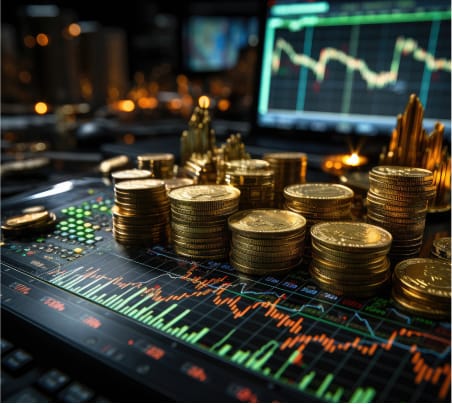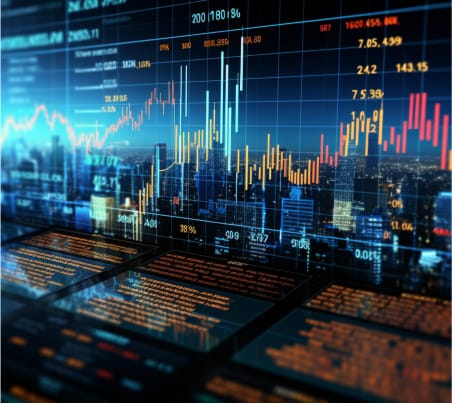Forex volatility plays a crucial role in trading outcomes. It refers to currency price fluctuations in the market. Traders must grasp its impact to navigate markets successfully.
Currency values constantly change due to various factors. Economic data, global events, and market sentiment influence these shifts. Understanding these forces helps identify risks and opportunities.
This article explores forex volatility in depth. We’ll examine its definition and contributing factors. You’ll learn how volatility affects your trading activities.
By understanding this key element, you can improve your strategies. This knowledge helps you capitalize on market movements. It also aids in managing risks effectively.
Key Takeaways
- Forex volatility refers to the degree of price fluctuations in the currency markets, reflecting the inherent uncertainty and risk associated with these financial instruments.
- Understanding the nature of forex volatility and its implications is essential for traders seeking to navigate the markets successfully.
- Forex markets are influenced by a range of factors, including economic data, geopolitical events, monetary policy decisions, and market sentiment.
- Navigating forex volatility requires a deep understanding of the forces driving the market and the potential risks and opportunities that volatility can present.
- Developing informed and effective trading strategies is crucial for capitalizing on market movements and managing risk effectively in the volatile forex market.
What is Forex Volatility?
Forex volatility measures how fast currency prices change over time. It shows how much a currency pair’s value fluctuates. Traders use this info to make smart investment choices.
Defining Volatility in the Foreign Exchange Market
Forex volatility is the size of price moves in a currency pair. High volatility means big price swings. Low volatility suggests a more stable market.
Factors Contributing to Forex Volatility
Several factors can increase forex market volatility:
- Economic news: New economic data can greatly impact currency values. This includes employment figures, inflation rates, and GDP reports.
- Geopolitical events: Political instability, trade disputes, and policy changes can create uncertainty. This uncertainty often leads to increased forex volatility.
- Central bank policies: Decisions on interest rates or monetary policy affect currency values. These choices can contribute to forex volatility.
- Market sentiment: The mood of forex market participants can drive price movements. Changes in investor outlook can impact volatility.
Grasping forex volatility and its causes is key for traders. This knowledge helps them navigate the ever-changing foreign exchange market.
Measuring Forex Volatility
Forex trading success hinges on understanding volatility, which measures currency price fluctuations. Traders who master measuring forex volatility make better decisions and manage risks effectively. Let’s explore key tools for assessing market turbulence.
Indicators of Forex Volatility
The Average True Range (ATR) is a primary metric for forex volatility. It calculates the average daily price range, revealing market volatility levels. Higher ATR values indicate larger price swings, while lower values suggest more stability.
Historical volatility analyzes past price fluctuations to predict future movements. By examining the standard deviation of past returns, traders can anticipate significant market shifts.
Implied volatility, derived from options pricing, offers insights into future market expectations. This forward-looking metric complements historical data, providing a well-rounded view of potential volatility.
| Volatility Metric | Description | How to Measure |
|---|---|---|
| Average True Range (ATR) | Measures the average daily price range | Calculated as the average of the absolute values of the difference between the daily high and low prices |
| Historical Volatility | Analyzes past price fluctuations to estimate future volatility | Calculated as the standard deviation of past returns |
| Implied Volatility | Reflects the market’s perception of future volatility | Derived from options pricing |
These tools for measuring forex volatility offer traders a comprehensive view of market conditions. By using them, traders can make more informed decisions and improve their trading strategies.

Impact of Forex Volatility on Trading
Forex volatility affects trading strategies and performance. It offers both opportunities and risks in the foreign exchange market. Traders must navigate these dynamic conditions carefully.
Increased Trading Opportunities
High volatility creates lucrative chances for savvy investors. Rapid price changes allow for profits on short-term movements. This environment supports strategies like scalping and day trading.
Heightened Risk Exposure
Volatility also increases risk for forex traders. Quick price swings can lead to significant losses. This is especially true for those using high leverage or aggressive strategies.
Effective risk management is crucial in volatile markets. Traders must be ready to handle increased volatility. They need to protect their positions from sudden market shifts.
Dealing with forex volatility on trading requires a careful approach. Traders must balance opportunities in volatile forex markets with risks of trading in volatile forex markets. Success comes from adaptive strategies and strong risk management.

| Opportunities | Risks |
|---|---|
|
|
Forex Volatility and Market Conditions
The forex market is a dynamic landscape where volatility shapes trading conditions. Understanding the link between volatility and market liquidity is crucial for traders. This knowledge helps them navigate the market more effectively.
Volatility During High Liquidity
High liquidity in forex means a large volume of trading activity. During these times, currencies may show more frequent and significant price changes. This creates both opportunities and risks for traders.
Increased liquidity allows for faster trade execution. It often leads to tighter bid-ask spreads. These conditions can benefit traders looking to profit from short-term market movements.
Volatility During Low Liquidity
Low liquidity occurs during reduced trading activity or economic uncertainty. In these conditions, the market can experience wider bid-ask spreads and slower execution times. Abrupt price swings are also more common.
Traders must be cautious and adjust their strategies in low liquidity. News events or economic data releases can have a bigger impact on currency prices. This amplified effect requires careful consideration when trading.













